The AMD A8-3850 Review: Llano on the Desktop
by Anand Lal Shimpi on June 30, 2011 3:11 AM ESTEver since the arrival of Conroe back in 2006, we've only really recommended AMD for its (sometimes incredible) value. Recommending AMD for those looking for absolute performance pretty much ended when the Pentium 4 retired.
AMD is looking to change that with the arrival of its first Fusion APUs. These APUs marry one or more AMD x86 cores with dozens if not hundreds of Radeon "cores" on a single die. While today the APU is little more than a cohabitation of these two computing architectures, the end goal is something far more integrated:

Llano is AMD's second Fusion APU, the first being Zacate which we met earlier this year. Llano shouldn't be all that unfamiliar to you either, the notebook version of the APU launched just two weeks ago. Our conclusions were as you'd expect: sub-par x86 performance but competitive battery life and great gaming performance for a value notebook. If gaming is going to be the most intensive thing you do on your notebook, you may find yourself wanting one based on a Llano APU.
Now it's time to look at Llano on the desktop. We previewed the desktop Llano alongside the mobile version but today we're back with much more detail. This article will focus on the basics: CPU performance, GPU performance and the associated details. Ian has a final review of one of the first desktop Llano motherboards - the ASRock A75 Extreme6 as well as a look at overclocking the new desktop APU. Finally Ganesh's article takes an in-depth look at how Llano works as an HTPC platform.
The APU
Although mobile Llano has to worry about fitting into thin and light notebooks, the desktop version has a lot more breathing room and as a result it comes to us in a pretty traditional package. Motherboard backwards compatibility is thrown out the window as you need pins to get video output from the APU to an on-board VGA/DVI/HDMI header and as a result we have a new platform: Socket-FM1.
Socket-FM1 is a 905-pin ordeal that looks reminiscent of the original Clawhammer CPU:
Despite the socket change, heatsink specifications haven't changed. All existing Socket-AM2/AM2+/AM3/AM3+ heatsinks should work just fine as long as they can handle the rated TDP of the chip you're cooling.
The desktop Llano launch starts small. AMD is only introducing four parts today, two of which will be available later:
| AMD Llano Desktop Lineup | |||||||||
| GPU | Total TDP (GPU + CPU) | CPU Cores | CPU Clock (Base/Turbo) | GPU Cores | GPU Clock | Price | |||
| AMD A8-3850 | Radeon HD 6550D | 100W | 4 | 2.9GHz | 400 | 600MHz | $135 | ||
| AMD A8-3800 | Radeon HD 6550D | 65W | 4 | 2.4/2.7GHz | 400 | 600MHz | $?? | ||
| AMD A6-3650 | Radeon HD 6530D | 100W | 4 | 2.6GHz | 320 | 443MHz | $115 | ||
| AMD A6-3600 | Radeon HD 6530D | 65W | 4 | 2.1/2.4GHz | 320 | 443MHz | $?? | ||
The A8-3850 and A6-3650 are going to be the first Llano APUs available, both carry a 100W TDP rating. While this may seem high, do remember that 100W is for the CPU and GPU combined.
Although Llano does support AMD's new Turbo Core technology, neither of the parts launching today have it enabled. The A8-3850 and A6-3650 run at 2.9GHz and 2.6GHz, respectively. The 3800 and 3600 will drop base clock speeds to hit a lower TDP but allow you to turbo up depending on workload. For an explanation of how Turbo Core works, flip back to our mobile Llano article.
Pricing is pretty reasonable. For $98 you can buy an Athlon II X4 640 running at 3.0GHz. For $37 more AMD will sell you an A8-3850 APU, effectively determining the price of the integrated GPU. AMD expects to see desktops built around the A6 to sell for $500 - $600, and A8 based systems to go for between $600 and $700
| CPU Specification Comparison | ||||||||
| CPU | Manufacturing Process | Cores | Transistor Count | Die Size | ||||
| AMD Llano 4C | 32nm | 4 | 1.45B | 228mm2 | ||||
| AMD Thuban 6C | 45nm | 6 | 904M | 346mm2 | ||||
| AMD Deneb 4C | 45nm | 4 | 758M | 258mm2 | ||||
| Intel Gulftown 6C | 32nm | 6 | 1.17B | 240mm2 | ||||
| Intel Nehalem/Bloomfield 4C | 45nm | 4 | 731M | 263mm2 | ||||
| Intel Sandy Bridge 4C | 32nm | 4 | 995M | 216mm2 | ||||
| Intel Lynnfield 4C | 45nm | 4 | 774M | 296mm2 | ||||
| Intel Clarkdale 2C | 32nm | 2 | 384M | 81mm2 | ||||
| Intel Sandy Bridge 2C (GT1) | 32nm | 2 | 504M | 131mm2 | ||||
| Intel Sandy Bridge 2C (GT2) | 32nm | 2 | 624M | 149mm2 | ||||
Architecturally desktop Llano is no different than its mobile counterpart. These are all quad-core parts with updated 32nm cores, boasting a ~6% increase in IPC over their 45nm Athlon II predecessors. Each core has a private 1MB L2 cache for a total of 4MB per quad-core APU.
The GPU side isn't different architecturally either, you're still looking at a Sumo core derived from AMD's Radeon HD 5570. Desktop Llano is available with either 400 GPU cores or 320 cores (you can get the mobile part with only 240 cores enabled as well). While the mobile parts top out at 444MHz, the extra TDP available in a desktop chassis allows AMD to ratchet up the GPU clock to 600MHz for the A8-3850.
AMD calls the two GPU configurations the Radeon HD 6550D and 6530D. Just like you can with mobile Llano, you can also pair a desktop Llano APU with a discrete GPU to have them both run in an asymmetrical CrossFire mode (with limitations of course):
| AMD Radeon Dual Graphics Branding | ||||
| Discrete GPU | 6550D | 6530D | ||
| HD 6670 | HD 6690D2 | HD 6690D2 | ||
| HD 6570 | HD 6630D2 | HD 6610D2 | ||
| HD 6450 | HD 6550D2 | HD 6550D2 | ||
The Chipset
I hate to keep drawing comparisons between desktop and mobile Llano APUs but we also have two chipsets on the desktop side: A75 and A55. The A75 chipset is the high end option with 6 x 6Gbps SATA ports and 4 x USB 3.0 ports:
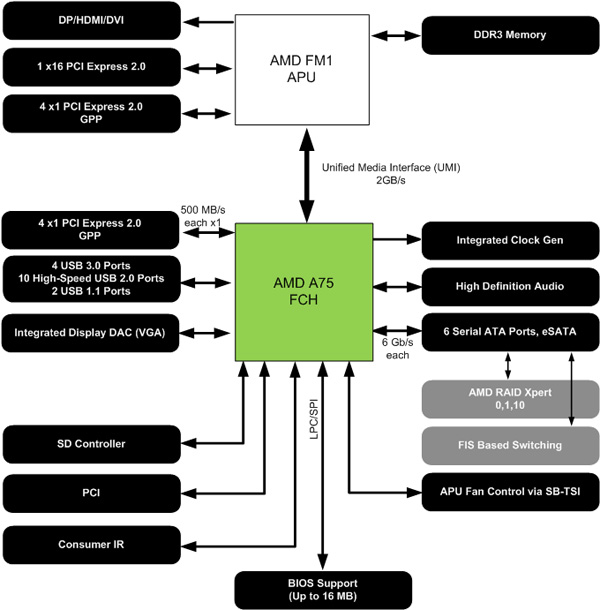
The A55 is the lower power, cost effective option that gets rid of all USB 3.0 support and backs down to 3Gbps SATA:
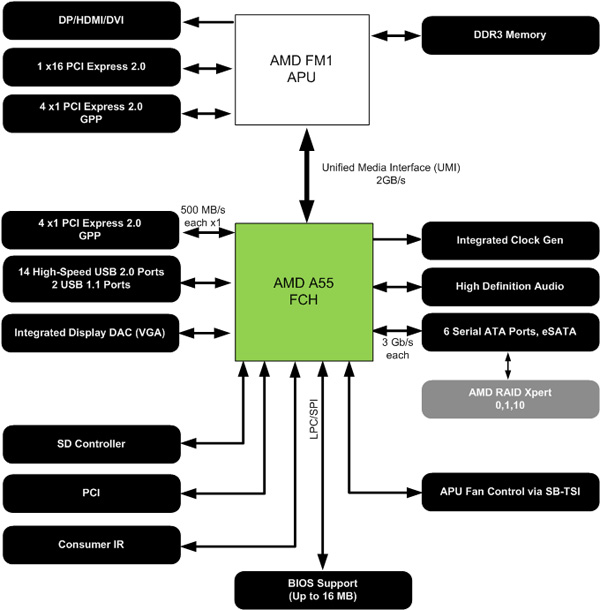


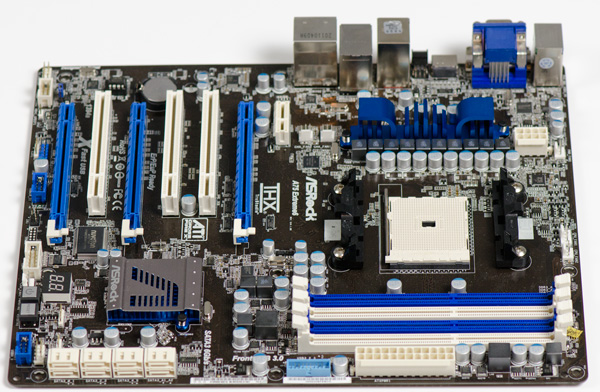
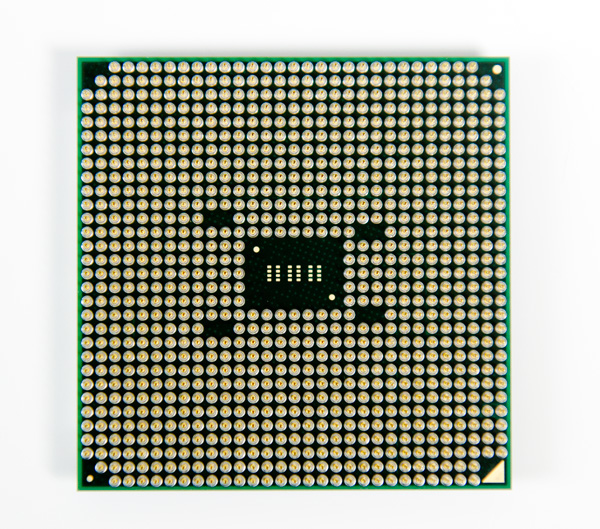
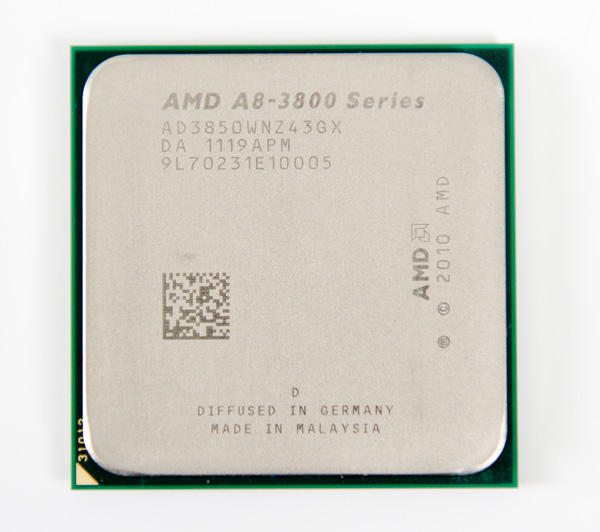
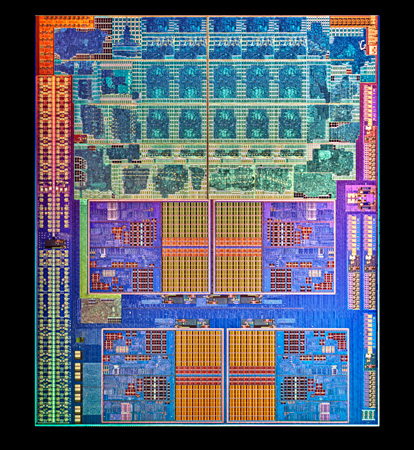








99 Comments
View All Comments
BSMonitor - Thursday, June 30, 2011 - link
He is not comparing Core 2's. He is talking about Athlon 64's and Pentium M's.No benchmarks are left from that era to compare against a Pentium M. That single core Celeron with modest cache is the closest thing to it.
HW_mee - Thursday, June 30, 2011 - link
Wow, who is he? L.? he does not mention any other processor than an i3 and seems to support my opinion.I agreed to look at the dual core Celeron you linked to, implying the single core side of my post is based of people who are to lazy to upgrade, and now you start talking about a single core Celeron... I am sorry buddy, but there is a picture on the Internet that shows the only way I can reply you:
http://img26.imageshack.us/img26/7522/impliedfacep...
BSMonitor - Thursday, June 30, 2011 - link
"You guys are very demanding users and seem to expect a lot from the average user.Going the list of people i know and their computers specification shows that none of them are even close to needing an i3-2100. the computers have a mix of single core Pentium M and ULV processors in the laptops and the desktops consist of a mix of old Athlons, post socket A, and first gen core processors."
OWNED
HW_mee - Thursday, June 30, 2011 - link
I will try again, patience, patience.....I still don't know who "he" is, as you replied to one of my post and you quote me, but you refer to a different person.
I will do a long list of the mentioned systems, and describe how well they handle the owners "average" usage. Remember I am not talking about "heavy" users, which I am sure you are, but average users.
If you think this list is boring, I think it is, just skip to the bottom of this reply.
The single core parts are beginning to dwindle, but they still tug along. Most of them simply get used as the owners, including me, think they are good enough for their purpose.
The Pentium M laptops are single core, only a few of those left, mainly due to lack of driver support for the crappy Intel IGP, which laptops back then often got equipped with.
They get used for basic office task and viewing flash. I posted one guys laptop somewhere in this comment section. Multitasking on these is limited ie. grooveshark + mail + office is the limit, but they get by. The Pentium M laptops get by as the users reach their requirement limit when they have some music going and are writing a document.
The ULV's consist of a couple of SU2700 equipped Lenovo's and a bunch SU7300 laptops. The single core SU2700 is the bottom of these laptops, but they can take the punishment of the average users, again music + writing is the limit of these average users. Most of the SU7300 laptops have often been bought as I recommended them some time ago and they do everything the average user expects of them.
I own one of the SU2700 machines and it is a great road warrior, I do not perform any "heavy" work on it, as that is not the purpose of a light laptop. I can multitask on this thing, multiple FF tabs with one tab running flash video, while writing/compiling a document and mixed background task. I often push this computer to the limit and switching applications does not happen instantly. Luckily I do not consider myself an average user.
My main complaint is the crappy Intel IGP, I load up a game and everything runs fine except for stupid graphical glitches such as missing textures, badly rendered textures and flickering areas.
The Athlon 64 computers consist of one single core and a bunch of dual core. They range from socket 939 to AM3 and they work just fine. The single core is actually being used by a "heavy" user and it is running great.
All the Athlon machines are used for every tasks the owners come up with, flash, video, gaming, music etc. and they have no problems handling it.
The only complaint among the Athlon processors is that the single core Athlon user thinks the computer is slow at compiling a new kernel and can't really handle full-HD video, but that is to be expected with a processor from 2003 ;-)
The first gen core processors refers to the good old 65 nm desktop parts ie. E6300, E4400 and so forth. These processors only seem to be limited by the user, as the casual user seems unable to image a processor intensive task.
That list contains very few single core processors, mainly Pentium M models and Intel ULV, note I did not write single/dual core at the desktops. Additionally I mentioned in a different reply only the laptops fit the single core computer at an average user scenario, which you seem frightened of.
++++ interesting again +++++++
You asked why I am looking at buying a new PC when my Pentium M can handle all my tasks.
Well I am not looking for a new PC, I just keep myself up to date in the hardware world, as people I know sometimes buy a new PC and ask me what they should buy.
The performance expectation from the average user is rising slowly. Single core is being replaced by dual core and so forth, but average hardware performance is growing faster than average user expectations.
The difference in average expectation and average performance has made my "job" of recommending hardware very easy.
processors have been plenty powerful since Core 2 Duo appeared, harddrives are massive, memory dirt cheap and now games can be handled with adequate graphics on something as low as an integrated GPU :-)
Feel free to call the average user a "whoo that is cool, email.. who knew!" moron, as that is the average user. They watch youtube, download music on Itunes, write e-mail, play a few games, download adware from the Internet etc. Most of these users are happy with something as crappy as a processor with a performance level available around 2005, and even worse some of them use a 4:3 monitor and enjoy games at resolutions below full-HD.
I am tired, going to bed now and leaving for an extended weekend.
BSMonitor - Thursday, June 30, 2011 - link
You are right, I switching between them.. it's this one:http://www.anandtech.com/bench/Product/72?vs=289
BSMonitor - Thursday, June 30, 2011 - link
And YES! Compared to the stated Pentium M, etc. single core nonsense you are spewing. Convert some songs in your iTunes library, have a flash movie playing, and be working on a document in your gmail account...I'll be done with both tasks and on to the next before your gamil document even opens.
HW_mee - Thursday, June 30, 2011 - link
I hope the 60 years old thing was a bad joke, as I almost laughed.I have just finished maintenance of a laptop used by one of my friends. The laptop is a HP NC8230 from 2006 equipped with a 1.86 GHz 2nd gen Pentium M, it is being used with/for the following:
Windows 7 enterprise, paid by the employer.
Office 2010, used for writing research articles.
Firefox & IE for online video, grooveshark, casual browsing etc.
He probably has other uses, but I can't remember them right now. The only complaint he has is load times and that is caused by the ancient and slow 80 Gb 5400 rpm harddrive.
BSMonitor - Thursday, June 30, 2011 - link
And he is doing none of those things simultaneously. Guarantee it. What he is using it for is typing text.HW_mee - Thursday, June 30, 2011 - link
One last reply, yawn.No he does not use windows and office at the same time..... idiot, do you want the facepalm link again?
It is not my computer, but I sometimes borrow it when I visit him.
I know that it usually has a word document running, 3 to 5 tabs open in FF one with Grooveshark, Outlook open with some blabla, mail, some Windows gadgets on the desktop and Sophos antivirus somewhere in the background.
The computer does get slow when Sophos starts crunching on the harddrive. Antivirus programs is one of the commonly known reasons to go for dual core and a fast harddrive.
If he starts watching flash video he stops Grooveshark, as he wants to listen to the video, but the rest of the programs remains open. Microsoft have actually implemented a great scheduler in Windows 7, as long as you have enough memory, even a single core processor can pull through a lot.
Gigantopithecus - Thursday, June 30, 2011 - link
I agree with your post almost entirely. My only disagreement is that I know very few people still using single core CPUs like the Pentium M and S754/939 Athlon Is. Those CPUs are no longer sufficient for basic tasks. However, they're also OLD. Any dual-core CPU aside from the Pentium D abominations and the Atom dual cores - and I include the first-gen Athlon X2s - is sufficient for basic usage.Your points that this platform is targeted more at OEMs than enthusiast DIYers and that SSDs and dGPUs being more important than CPUs to overall system quality are, imho, very poignant.